
|
|
Hi, let us introduce ourselves: we are a group of twenty mothers living in the centre of Naples and we are attending a course of English language organized by our children's school.
We wish to be helpful to the several tourists crowding Naples in these years by giving them some suggestions about what to visit in this beautiful town.
There are lots of guides focused on adults' interests , but what about children? All of us know how it's hard travelling with children: visiting new places it's interesting and discovering them together with our chilren makes it even more pleasant.
But children soon get sick of museums and churches and a nice experience can turn into a nightmare if you aren't able to propose them amusing or diverting activities.
Our main aim is giving a hand to those tourists facing a journey with their little children by pointing out some attractions that can be interesting both for adults and children.
So, if you are interested in this topic, visit this blog in the next weeks: we are going to fill it with more and more information.
Area personale
Tag
Cerca in questo Blog
Menu
I miei Blog Amici
Ultimi commenti
Chi può scrivere sul blog
The best way to get to know Naples is to walk around its ancient streets in the historical centre. Your children also will find walking in its characteristics streets very amusing and interesting, with its old craftsmen’s shops and laboratories. But, we recommend that you are careful in the chaotic traffic in the city centre. It can be very dangerous, especially for your children, as cars and motocycles shoot out from all directions disregarding traffic-lights and pedestrian crossings. So, always keep an eye on your children. The most characteristic street in Naples, is the most ancient one: Spaccanapoli. Its name means “Split Naples”, as this road literally splits the ancient city centre into two parts. Spaccanapoli is a long straight road and on both its sides a labyrinth of narrow lanes spreads out, where you can still see Naples traditional way of living, and at the same time history surrounds you with churches, historical palaces, squares and so on. Along Spaccanapoli, in fact, there are some of the city’s most important monuments: the huge church spire “Guglia dell’Immacolata”; the Church of Gesù Nuovo, with its interior in a wonderful Baroque style; The Monastery of Santa Chiara, in Gothic Style, with its splendid courtyard. Coming from Church of Gesù Nuovo, past the Monastery, turn left and walk along via San Sebastiano (full of musical instruments shops and lute-makers’ laboratories), then you will get in Piazza Bellini, that is a square full of life, with open-air cafeterias around the monument built to commemorate the composer Vincenzo Bellini, who studied in Naples at the Academy of Music that is at a few steps from the square. In the square you can admire the archaeological remains of the ancient Greek walls that once stood on the square’s site. After a while of rest in the cafeterias or giving a look to the book stalls (most of them specialized in art books) in the near Port’Alba street, you can reach in a few minutes via San Gregorio Armeno. This road is famous worldwide as the “nativity scene road” because there are several craftsmen’s laboratories that makes figurines for nativity scenes, and who still use traditional methods. There are figurines of all kinds and of all prices, from the cheap ones (simple but very accurate) to the most expensive ones, worth to be exhibited in Museums for their faithfulness to the 17th century handicraft and the luxury in materials. The nativity scenes are on sale all year round, but in Christmas term this road is overwhelmed by crowds of tourists and Neapolitans. Your children will love this place, where they will admire the stunningly rich in details “presepi”, offering a lively and colourful representation of the uses and costumes of the life in Naples in the 17th century. In fact the “nativity scenes” were not meant to be historically true and so they did not mirrored the biblical life, but they were a show of the contemporary people’s life. So you will find the figurine of the “pizzaiolo” (pizza cook) or the greengrocers’s stall with tomatoes and potatoes in exhibition. Your children will be amused by the realism of these reproductions, for example the mills with real water endlessly flowing or the self-moving authoma-figurines (the old woman baking pizza, the fisher, and so on). They will also be able to recognize in some figurines contemporary personages (like the Pope, famous actors or politicians) as some artisans every year conceive a new figurine inspired by contemporaries facts and this is for them an original way of advertising their laboratory.
By Chiara and Rosaria
|
|
In one of the narrow streets spreading from Spaccanapoli, via De Sanctis, you can visit the Sansevero Chapel. This palace dates from the first half of the 16th century, but it was radically transformed in the 18th century by Prince Raimondo di Sangro, a legendary figure of alchemist and erudite about whom there are many mysterious anectodes, partly derived from popular imagination, partly from the undoubted originality of his character. This chapel was the burial place for the members of the de Sangro family, princes of Sansevero, and Prince Raimondo di Sangro planned its restoration calling the most illustrious artists and sculptors of the time. The Prince planned a great number of allegorical sculptures which were part of a single overall project for decorating the chapel but were sculpted by different artists as Corradini, Sammartino, Queirolo. The most admired work of art in the chapel is the Veiled Christ by the sculptor Sammartino, impressive for its beauty at once sublime and human. You and your children will be amazed by the perfection of this statues, which astonishing reality in some details like the transparency of the veils and the shrouds, the net in the “Disenchantment” group, arouse several legends about the methods that were used in order to attain such a faithfulness to reality. For instance, stories went that the veil of the Christ was not carved in marble but was a real shroud magically petrified. In the cellar of the chapel are displayed the so called “anatomic machines”. They are the reproduction made of coloured wax and iron threads of the blood vessel system of two human bodies (of a male and of a pregnant woman). In fact the Prince was a medicine scholar, also, and these reproductions had the aim to show the investigations he had made in order to have a better knowledge of human physiology. But the people, that suspected the Prince dissected dead bodies, charged him with necromancy and stories went that the corpses in the cellars were those of two servants horribly tortured for his devilish experiments. Children like being a little bit frightened and so they will be fascinated by this mysterious reproductions and will surely ask you “Are they real people?” showing the same wonder that felt the simple people three centuries ago looking at the complexity of the human body.
By Annarita
|
|
From Via San Gregorio Armeno you can get to Via dei Tribunali, which was once a major street of Greek Roman Naples. At the end of this street you will find the entry to the fascinating world of underground Naples. This is a “city under the city” that is exceptionally old: archaeological digs have found artefacts dating back 5000 years. The Greeks built here their necropolis, while Romans built aqueducts and tunnels used as streets to avoid climbing some Mount Piedigrotta. To the Roman era dates back also the hidden theatre , that was in that period one of the more important and open theatre, where even the emperor Nero performed . So every historic happening, from the foundation of the ancient Greek nucleus (Palepolis) to the WWII bombs (when the former aqueduct tanks were used as shelters) , left its marks on the walls of the yellow tufa stone with which city was built. The public can now visit some parts of these underground areas accompanied by a guide in a two hours tour. Excursions take place daily from 10.00 am to 6.00 p.m. every two hours. We suggest you to have a sweater at your disposition , even when outside is hot, as in the underground is much more colder and wet. Your children will find amusing and thrilling this excursion in the vessels of Naples, characterized by narrow and dark passages, enlightened by torches, and that will finally take you into a large tank of crystalline water, like an underground pool.
By Rosanna
|
|
Children are always fascinated by stories of kings and knights. So they will be certainly interested in a tour of Neapolitan castles.
Naples has got 4 castles and 3 Royal Palaces, located in different areas of the city and with different origins. The most famous is Castel dell’Ovo, with its characteristic shape standing out on the Neapolitan seashore. The building is located on a small island, the Megaride, that is the first inhabited nucleus in Naples, founded in the 6th century B.C. Here the Roman patrician Lucullus built his villa in the 1st century B.C. Here was exiled the last western Roman Emperor, Romolus Augustulus, in the 5th century A.D. On the remains of the Villa, Normans built a castle in 12th century. But it lost its importance when in 13th century the new king Anjou built a more comfortable and safer castle, the Maschio Angioino, also called Castelnuovo (new castle)and moved his court there.
The castle’s name spreads out from a medieval legend telling that the latin poet Virgil, who in middle age was believed to be a sorcerer, put a magical egg into the foundations of the castle to support them, and foresaw that if the egg broke, it would have been the end for the castle and doomsday for Naples. This castle offers a magnificent view of the gulf of Naples from its terraces and inside it often go exhibitions and other special events. In the 1800 a small fishing village (Borgo Marinari) sprung up around the castle, this village is still existing but is now renowned for its picturesque marina and several fine restaurants.
The other castle, that is the first monument you see coming from the sea, is Castel Nuovo that, was built for strategic reasons, in order to warden the port by the new French dominators. It is in Gothic style, with 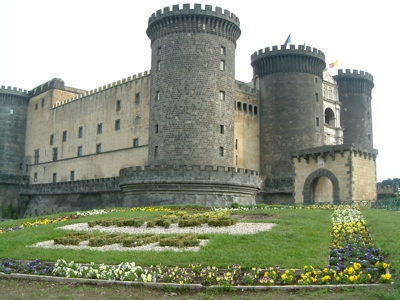 5 towers, and its Chapel was decorated by frescoes by Giotto, but unfortunately, almost nothing is left of them. It was radically restored by the following dominating dynasty, the Aragona.
5 towers, and its Chapel was decorated by frescoes by Giotto, but unfortunately, almost nothing is left of them. It was radically restored by the following dominating dynasty, the Aragona.
A famous triumphal arch was added to the main gate to celebrate Alfonso d’Aragona’s entrance in Naples.
In a hall of the castle the famous Barons conspiracy against King Ferrante, Alfonso's son, occurred. The King had invited the barons for a feast; but, a certain point, he had the garrison close all the hall's doors and all the barons were arrested and later executed. The Barons' Hall was the seat of the Council of the commune of Naples until 2006.
by Gaia
|
|
A visit to the Reggia (Royal Palace) will give you the opportunity to admire wonderful masterpieces and in the meantime to enjoy a peaceful walk in the wide park surrounding the palace. This Royal Palace was built in the beginning of the18th century by will of  the king of Naples, Carlo III di Borbone. Originally it was meant only as a hunting “casino” on the lovely hill of Capodimonte, but, then, the project was widened and, under the king Ferdinand IV, entrusted to the architect Ferdinando Fuga. The Reggia was built in a classical style and it was also conceived to display the magnificent collection of paintings belonging to King Carlo. Nowadays, the Reggia is a Gallery of Art, ranging from 1300 to contemporary art, where you can admire paintings by Botticelli, Raffaello, Tiziano, Correggio, and so on. A precious piece of the collection is the sequence of seven Flemish tapestries from 16th century, showing episodes from the “Battle of Pavia”. Other pieces of the collection are embroideries, weapons, porcelain, majolicas , etc.
the king of Naples, Carlo III di Borbone. Originally it was meant only as a hunting “casino” on the lovely hill of Capodimonte, but, then, the project was widened and, under the king Ferdinand IV, entrusted to the architect Ferdinando Fuga. The Reggia was built in a classical style and it was also conceived to display the magnificent collection of paintings belonging to King Carlo. Nowadays, the Reggia is a Gallery of Art, ranging from 1300 to contemporary art, where you can admire paintings by Botticelli, Raffaello, Tiziano, Correggio, and so on. A precious piece of the collection is the sequence of seven Flemish tapestries from 16th century, showing episodes from the “Battle of Pavia”. Other pieces of the collection are embroideries, weapons, porcelain, majolicas , etc.
The Reggia is surrounded by a vast park, the biggest green area in Naples, rich in the variety of vegetation, with majestic secular trees. In some areas of the park (normally, the area near the entrance) you could even arrange a picnic for your children or eat a pizza taken away from one of the pizzeria in front of the main gate of the Reggia. Then, the children will have the opportunity to run, rent a bike or play football on the grass (there are lots of pedlars selling balls, toys and drinks inside the park). There is also the chance to enjoy a ride on one of the cabs strolling along the alleys of the park. So, as you see, it’s a place where all your family can enjoy a very pleasant day.
By Titti A.
|
|
 Your older children will certainly appreciate a visit to the excavations of Pompei, the only archaelogical site which gives the real image of a roman city. This is due to the particular burial (under a blanket of 6 meters of ash and rock) caused by the eruption of the Vesuvius in 79 AD. For your children will be like hopping into their history book : Pompei was a Roman colony, enriched with private and public buildings, especially in the age of the emperors Augustus and Tiberius, from 27 B.C. to 37 A.D, destroyed by the sudden eruption of the Vulcan “Vesuvius”.The buried city was rediscovered in the 16th century, but exploration only began in 1748, and continued systematically through the nineteenth century up to the most recent excavations, aimed at restoring and attributing the proper value to the ancient city and its exceptional archeological heritage.
Your older children will certainly appreciate a visit to the excavations of Pompei, the only archaelogical site which gives the real image of a roman city. This is due to the particular burial (under a blanket of 6 meters of ash and rock) caused by the eruption of the Vesuvius in 79 AD. For your children will be like hopping into their history book : Pompei was a Roman colony, enriched with private and public buildings, especially in the age of the emperors Augustus and Tiberius, from 27 B.C. to 37 A.D, destroyed by the sudden eruption of the Vulcan “Vesuvius”.The buried city was rediscovered in the 16th century, but exploration only began in 1748, and continued systematically through the nineteenth century up to the most recent excavations, aimed at restoring and attributing the proper value to the ancient city and its exceptional archeological heritage.
Your children will realize, walking along the ancient streets of Pompei, peeping into the houses decorated with frescoes and mosaics, admiring the temples ad the forum, how the life of ancient people was similar to our life: their interest will be roused by the ‘bakery’ with its wood-burning oven, similar to those used today, and the millstones , b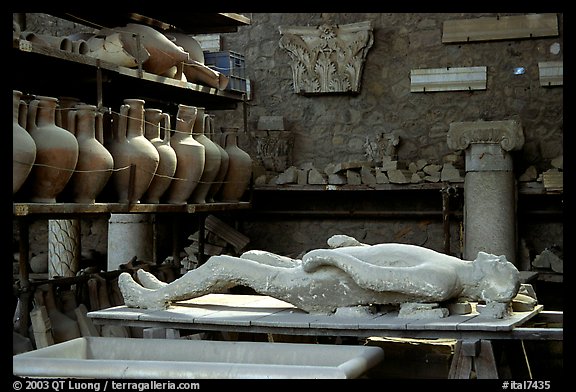 y the theatres and the perfectly preserved amphitheatre, used for gladiator battles, and that was “disqualified' for 10 years because of a violent riot that had broken out between ‘fans’ from Pompeii and Nocera. Finally they will be moved by the garden of the fugitives, a large space cultivated as a vineyard, which houses the plaster casts of some of the victims from 79 AD, overcome by the fury of the eruption while they were seeking an escape.
y the theatres and the perfectly preserved amphitheatre, used for gladiator battles, and that was “disqualified' for 10 years because of a violent riot that had broken out between ‘fans’ from Pompeii and Nocera. Finally they will be moved by the garden of the fugitives, a large space cultivated as a vineyard, which houses the plaster casts of some of the victims from 79 AD, overcome by the fury of the eruption while they were seeking an escape.
The excavations are open every day from 8.30 a.m. to 5 p.m. in winter, and from April to October every day from 8.30 a.m. to 7.30 p.m. You can get there by the Circumvesuviana Train, line Naples-Sorrento and get off at the stop Pompei Scavi - Villa dei Misteri. The ticket price is € 11.00, but the entrance is free for EU citizens under 18 years.
Mind that this excursion is rather tiring, so it is not advisable to go there with little children. Moreover, in summer it is better to visit the excavation in the early morning or in the late afternoon, when the sun is not too hot.
By Titti C.
|
|
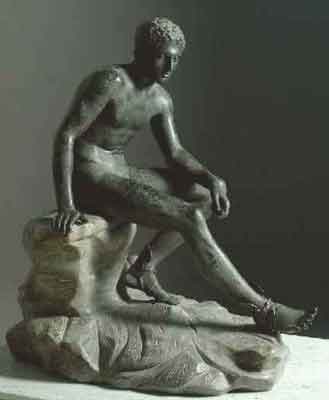 After having visited the Pompei excavations, your children will be curious to see what has been found there. The finds of Pompei and Herculanum are displayed in the National Archaelogical Museum of Naples, one of the most important cultural centres in the world in terms of the quantity and quality of Greek and Roman relics it contains.The museum bulding, constructed in 1585, is in the historical centre of Naples, in Piazza Museo. You can get there from the station by several buses and by underground also.
After having visited the Pompei excavations, your children will be curious to see what has been found there. The finds of Pompei and Herculanum are displayed in the National Archaelogical Museum of Naples, one of the most important cultural centres in the world in terms of the quantity and quality of Greek and Roman relics it contains.The museum bulding, constructed in 1585, is in the historical centre of Naples, in Piazza Museo. You can get there from the station by several buses and by underground also.
Most notable among the various exhibits and rooms are the Farnese Hercules; the Farnese Cup a splendid example of cameo, once a part of Medici collections; the Halls of Villa Papyri, where numerous sculptural exhibits are displayed, brought here from excavations a the Herculaneum villa; the Doryphorus, an admirable copy after the original by Polyclitus; Many of the mosaics come from the House of Faun located in Pompeii. Of the mosaics the most noted is the one depicting the Battle of Issus, which was fought between Alexander the Great and Persians who were ruled by King Darius.  The frescoes located throughout the museum give us some wonderful insight into the everyday life in these cities during Ancient times. These paintings range from human sacrifices to burial rites to the beginning of spring.
The frescoes located throughout the museum give us some wonderful insight into the everyday life in these cities during Ancient times. These paintings range from human sacrifices to burial rites to the beginning of spring.
Your children will be fascinated also by the Egyptian collection, where they will admire some mummies also, among which the one of the crocodile with its baby.
They will be guided through the rooms of the museum by two friends, Camilla and Napolino: two characters that, through their adventures, will explain to the young visitors, in a non-conventional way, 24 works of art.
By Tea
|
|
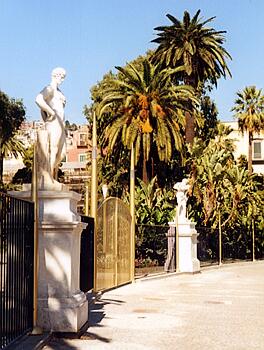 The Villa Comunale Garden is a long public garden that separates the Riviera di Chiaia from Via Caracciolo, the long promenade in front of the sea. There, you can enjoy some shadow and rest while admiring the panorama, after having strolled along the seaside. Its realization dates back to the 1780and its project was inspired by the Tuileries Gardens in Paris. The alleys are adorned by classical statues, secular trees, fountains. There is also a beautiful orchestral stage (cassa armonica) made of glass and cast iron where on Sundays people enjoys concerts and band exhibiti
The Villa Comunale Garden is a long public garden that separates the Riviera di Chiaia from Via Caracciolo, the long promenade in front of the sea. There, you can enjoy some shadow and rest while admiring the panorama, after having strolled along the seaside. Its realization dates back to the 1780and its project was inspired by the Tuileries Gardens in Paris. The alleys are adorned by classical statues, secular trees, fountains. There is also a beautiful orchestral stage (cassa armonica) made of glass and cast iron where on Sundays people enjoys concerts and band exhibiti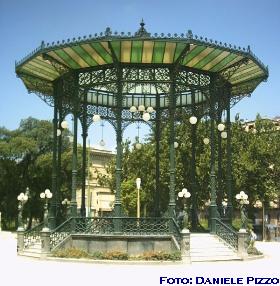 ons. Your children will amuse themselves on the swings and slides there available and all of you can taste a delicious ice-cream comfortably seated at the chalets (cafeterias), breathing the sea breeze, as several Neapolitans do on Sundays. On Sunday mornings, a flea market takes place in the villa, where you can find several interesting and odd items .
ons. Your children will amuse themselves on the swings and slides there available and all of you can taste a delicious ice-cream comfortably seated at the chalets (cafeterias), breathing the sea breeze, as several Neapolitans do on Sundays. On Sunday mornings, a flea market takes place in the villa, where you can find several interesting and odd items .
by Giusy
|
|
 Inside the Villa there is the Aquarium, the most ancient in Europe, the best way to discover the Mediterranean sea fauna. It was founded by the German naturalist Antonio Dohrn and its success was determined by the innovative system for pumping water directly from the sea into the cisterns where the captured exemplars were kept and that was, then, imitated in many other aquariums. The aquarium is a very fascinating place, very different from the modern ones, because of its sombre atmosphere, in which the 23 tanks on display use volcanic rocks to create a natural setting and are chiefly illuminated by daylight from the skylights in the roof. All the fauna is from the Bay of Naples, that is very rich in marine life. There you will admire Gorgonie, underwater flowers, polyps, moray eels hiding themselves in Roman amphorae and crabs lurking in the gloom, lobsters, coral sand even calamaries (very delicate specimen that generally do not survive in captivity). Your children will be certainly fascinated by the particular atmosphere of this aquarium, able to plunge them in the depth of the sea with its silence and succession of darkness and light.
Inside the Villa there is the Aquarium, the most ancient in Europe, the best way to discover the Mediterranean sea fauna. It was founded by the German naturalist Antonio Dohrn and its success was determined by the innovative system for pumping water directly from the sea into the cisterns where the captured exemplars were kept and that was, then, imitated in many other aquariums. The aquarium is a very fascinating place, very different from the modern ones, because of its sombre atmosphere, in which the 23 tanks on display use volcanic rocks to create a natural setting and are chiefly illuminated by daylight from the skylights in the roof. All the fauna is from the Bay of Naples, that is very rich in marine life. There you will admire Gorgonie, underwater flowers, polyps, moray eels hiding themselves in Roman amphorae and crabs lurking in the gloom, lobsters, coral sand even calamaries (very delicate specimen that generally do not survive in captivity). Your children will be certainly fascinated by the particular atmosphere of this aquarium, able to plunge them in the depth of the sea with its silence and succession of darkness and light.
by Giusy
|
|
 You and your children can enjoy a relaxing walk in the Botanical Garden, a quiet spot of verdant nature right in the chaotic centre of Naples. Located in via Foria, at the borders of the historical centre, it is one of the biggest in Italy for consistency of the collections and by extension. It dates back to the beginning of the 19th century and was founded with educational and scientific purposes. It has an area of 12 hectares with 10.000 species present. There you can admire the felceto and the palm grove; typical plants of the Mediterranean area, like the citruses; officinal plants and plants that require special acclimatization, that is the immense representation of Ninfee in appropriate bathtubs and in a better exposed area, the so-called desert, the wide collection of fat plants. Inside the Garden there is the Museum of Paleobotanica, introducing a collection of fossils and objects made of vegetable material.
You and your children can enjoy a relaxing walk in the Botanical Garden, a quiet spot of verdant nature right in the chaotic centre of Naples. Located in via Foria, at the borders of the historical centre, it is one of the biggest in Italy for consistency of the collections and by extension. It dates back to the beginning of the 19th century and was founded with educational and scientific purposes. It has an area of 12 hectares with 10.000 species present. There you can admire the felceto and the palm grove; typical plants of the Mediterranean area, like the citruses; officinal plants and plants that require special acclimatization, that is the immense representation of Ninfee in appropriate bathtubs and in a better exposed area, the so-called desert, the wide collection of fat plants. Inside the Garden there is the Museum of Paleobotanica, introducing a collection of fossils and objects made of vegetable material.
The garden is open in the morning until 14.00. The entrance is free.
By Anna
|
|
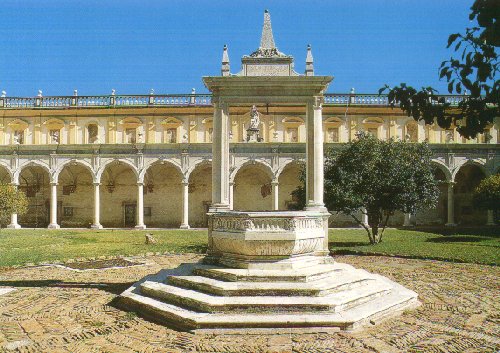 From the top of the Vomero hill, you can admire a magnificent view over the city, the gulf and the islands. A visit to the former Carthusian monastery will give you the opportunity to take a little rest from the mess of Naples city centre and enjoy some moments of peace in its gardens.
From the top of the Vomero hill, you can admire a magnificent view over the city, the gulf and the islands. A visit to the former Carthusian monastery will give you the opportunity to take a little rest from the mess of Naples city centre and enjoy some moments of peace in its gardens.
Built in the 14th century, the monastery was completely renovated in the 17th century by the ingenious architects Conforto and Fanzago who designed its present Neapolitan Baroque look. The church is rich in marble decoration and beautiful baroque pictures by Ribera, Stanzione and Luca Giordano.
If you want to get acquainted with Naples history 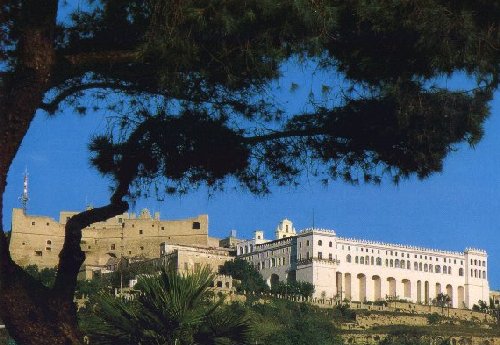 and art between 17th and 19th centuries, you will find a visit to the museum inside the monastery very interesting. Even your children will appreciate many of the sections of the museum. They will certainly admire the models of royal ships in the naval section, garments , fans , jewels and snuff boxes , and above all they will be fascinated by the section containing the Neapolitan nativity scenes, the “presepi”. Here a remarkable collection of shepherds and nativity scenes is stored. The shepherds are the work by prestigious craftsmen from the 18th century Neapolitan school and are made with extreme accuracy of ceramic and of wood and dressed in fine embroidered clothes made of silk or wool. The most significant of these masterpieces is the Cuciniello Presepe, which is one of the most admired exhibits in the whole museum. Outside the Monastery you can taste a delicious ice-cream with your children while you admire the panorama by means of the telescopes placed on the esplanade or go window-shopping of the little jewelleries near the monastery, selling artworks by Neapolitan goldsmiths like cameos and coral jewels.
and art between 17th and 19th centuries, you will find a visit to the museum inside the monastery very interesting. Even your children will appreciate many of the sections of the museum. They will certainly admire the models of royal ships in the naval section, garments , fans , jewels and snuff boxes , and above all they will be fascinated by the section containing the Neapolitan nativity scenes, the “presepi”. Here a remarkable collection of shepherds and nativity scenes is stored. The shepherds are the work by prestigious craftsmen from the 18th century Neapolitan school and are made with extreme accuracy of ceramic and of wood and dressed in fine embroidered clothes made of silk or wool. The most significant of these masterpieces is the Cuciniello Presepe, which is one of the most admired exhibits in the whole museum. Outside the Monastery you can taste a delicious ice-cream with your children while you admire the panorama by means of the telescopes placed on the esplanade or go window-shopping of the little jewelleries near the monastery, selling artworks by Neapolitan goldsmiths like cameos and coral jewels.
by Marianna
|
|
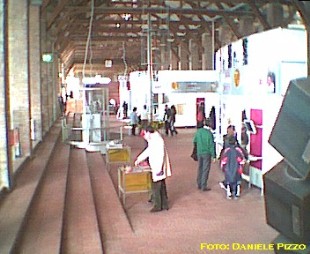
You have to book the workshops by phoning the booking office (tel. 081 7352390).
Your children can spend an enjoyable day playing games, doing experiments, getting involved in scientific activities, discovering the reasons behind the phenomena surrounding us, travelling through the stars in the biggest Planetarium of Southern Italy, communicating with modern networks, in a place planned especially for them. In fact, there are workshops where they can play with their senses and experience emotions with light, sounds, colours and playing with other children. If your children have a streak of creativity they can get involved in activities as pottery, metals, wood, plastics, fabrics. In the meantime the parents can relax in its cafès, shops and square overlooking the sea.
By Valentina and Carla
|
|
If you wish to entertain your children in a classic way, you could take them to Edenlandia, a theme park spread out over 50,000m2 in which adults and children can spend fun-filled, unforgettable days and evenings. Your children will find 13 games for prizes, 25 rides, 15 refreshment points, a bureau de change, telephones, toilets, mini fountains, a theatre, virtual reality, a roller coaster experience and lots more. It is easily accessible by car and by public transport: take the underground and get off at the Campi Flegrei stop. The admittance is EUR 2 per person and 12 Euros for the “bracciale dell’allegria” (fun bracelet) that allows you to get on most of the fair.
Open Hours: 5pm-midnight Mon-Fri; 10am-midnight Sat-Sun
By Olga
|
|
On the way to the Vesuvius, you could pay a visit to this Museum, located in Santa Maria del Pozzo. Your children will be interested in seeing directly how the daily life of countryside people was until a few decades ago. They can see the traditional arts and crafts come to life again: More than 3000 objects and tools are displayed in the museum, but they aren’t just exhibited:in fact, skillful artisans and farmers work in this museum and they interpret old jobs using authentic ancient implements and tools. So they will see the mattress-maker (o’ cardalana) busy in his occupation and they will get acquainted with the job of the “basketmaker” (o’spurtellaro)and of the spinner (a’ filatrice), they will wonder at the existence of jobs now disappeared as the “dish mender” (o’ conciapiatti) and the “scissor sharpener” (o’ molaforbice) testifying a time when things were repaired and recycled in appalling contrast with our contemporary habits.
Your younger children will enjoy above all the visit to the farm animals: poultry, oxes, cows, etc. There is also an orchard with educational purposes: your children will be explained how hard was the farmer’s job, which were the ways to cultivate the soil. They will be showed officinal, aromatic and medicinal plants, and will admire the age-long walnut tree and the orange-grove.
Often, evening performances are organized in the vast area belonging to the museum: performances of plays and recitals of traditional folklore music.
This educational museum is open from Tuesday to Friday at 9.00-13.00; weekend and Public holidays at 9.00-13.00 and at 16.30-20.00.
TICKETS PRICE: 1 ticket euro 1,55; 1 ticket with tourist guide euro 5.00.
By Antonella
|
|
 All the children are fascinated by trains, so a visit to this museum will be very interesting for them.
All the children are fascinated by trains, so a visit to this museum will be very interesting for them.
This museum is located in a vast area, between the railway and the sea, in Pietrarsa, near to Portici, a town in the big suburban area of Naples, and stands on the site of the old Bourbon workshops of the State Railways where locomotives were built. In fact, the first Italian railway was the Naples – Portici line, inaugurated in the 1839, and the locomotive, called “Vesuviana” after the name of the Vulcan, was built in Naples with pieces from England and was able to run at a speed of 60 km/h.
In this museum are displayed all kind of locomotives, transported to Pietrarsa from all over the country.
By Stefania
|
|
 If you are travelling with your children, you will certainly appreciate the opportunity to use an amusing and relaxing way to visit Naples: the citysightseeing red buses . Three itineraries are offered:
If you are travelling with your children, you will certainly appreciate the opportunity to use an amusing and relaxing way to visit Naples: the citysightseeing red buses . Three itineraries are offered:
Line A: it goes through the most representative places of art in the historical centre of Naples as the Archeological Museum, the Capodimonte Museum, the ancient Piazza del Gesù.
Line B: along this itinerary you will discover the gulf of Naples and admire the Villa Comunale gardens, the most famous sea promenade “Mergellina”, the fishing boats at Borgo Marinari and the ferries to the the islands, then the bus will slowly climb the hills towards Posillipo. allowing you to behold the wonderful sight of the Vesuvius mirroring itself in the blue waters of the mythical gulf.
Line C: it is available in the weekends and will take you up to the Vomero hill, on which top there is the Carthusian Monastery of St. Martin.
Each itinerary lasts 60 minutes. There are races every 30 minutes from 9:00 am to 11.00 pm in summer and from 9.00 am to 6 pm during the rest of the year.
The ticket price is 18 € for the adults and 9 € for children from 6 to 15 years old.
Tickets are valid for 24 hours and multilingual commentaries are available on board.
It’s really a comfortable way to visit Naples, as you can hop off the bus at the dedicated bus stops, stroll in the streets of Naples for shopping or in order to taste some gastronomic delicatessens and then hop again on the bus within the 24 hours of validity of the ticket.
by Tamara
|
|
Strolling in the streets of Naples, you will be certainly attracted by the charms of the wares on show in the shop-windows or displayed on the stalls , generally at a rather convenient price.
We would recommend you never accept straight off the price the shopsellers will tell you, but to haggle about the price . Generally, the shopsellers will offer you their goods at a higher price as they expect tourists to ask for some discount. So, after a little bit of negotiation, they will be glad to allow you a discount and both of you will be satisfied. It’s an aspect of the local folklore and it makes more interesting and amusing your shopping .
In Naples you can find shoes and leather hand-made goods at a very convenient price. If you wish to buy a present for your husband , you would make him happy with a tie from the internationally  renowned boutique “Marinella”. If you are looking for nice and original souvenirs from Naples, you will certainly find something that will fit your request at the “Napolimania” shops (you can find one of them in Via Toledo, inside the Airport terminal and the railway station). If you are fond of the Capodimonte figurines made of fine porcelain, you will find a wide choice of these artworks in the manifactures near the Capodimonte Museum. Instead, if
renowned boutique “Marinella”. If you are looking for nice and original souvenirs from Naples, you will certainly find something that will fit your request at the “Napolimania” shops (you can find one of them in Via Toledo, inside the Airport terminal and the railway station). If you are fond of the Capodimonte figurines made of fine porcelain, you will find a wide choice of these artworks in the manifactures near the Capodimonte Museum. Instead, if you have been fascinated by the nativity scenes you have admired in the churches and museums of Naples, the best place where you can buy them is in Via San Gregorio Armeno, in the very heart of Naples, where all types of shepherd figurines are displayed, ranging from very cheap ones to some very expensive exemplars, worthy to be in exhibition in a museum. For your children some of the typical Neapolitan pastries will certainly be the most welcome gift : you can choose among sfogliatella, babà (flavoured with rum or limoncello), struffoli, and the traditional Easter cake,
you have been fascinated by the nativity scenes you have admired in the churches and museums of Naples, the best place where you can buy them is in Via San Gregorio Armeno, in the very heart of Naples, where all types of shepherd figurines are displayed, ranging from very cheap ones to some very expensive exemplars, worthy to be in exhibition in a museum. For your children some of the typical Neapolitan pastries will certainly be the most welcome gift : you can choose among sfogliatella, babà (flavoured with rum or limoncello), struffoli, and the traditional Easter cake, 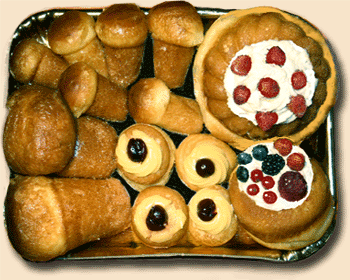 the pastiera (a dessert made from wheat and ricotta cheese, flavoured with orange blossom essence).
the pastiera (a dessert made from wheat and ricotta cheese, flavoured with orange blossom essence).
by Svetlana
|
|





Inviato da: peluches le blog
il 16/08/2013 alle 10:27
Inviato da: vivienne westwood
il 13/10/2011 alle 10:03
Inviato da: tattoosupplies888
il 08/09/2010 alle 10:11
Inviato da: Anonimo
il 23/03/2008 alle 16:43
Inviato da: Anonimo
il 25/12/2007 alle 22:43